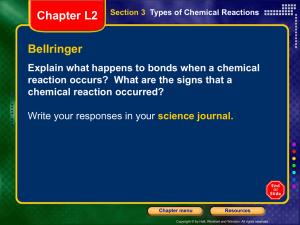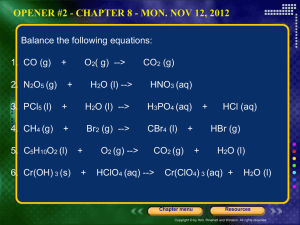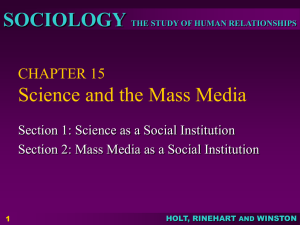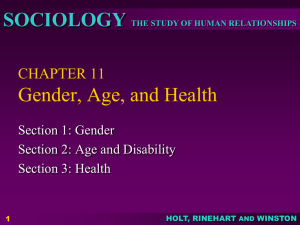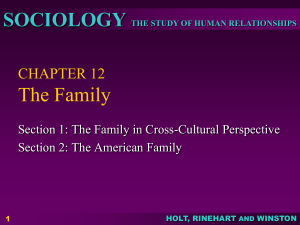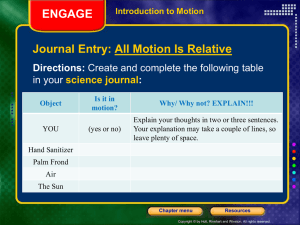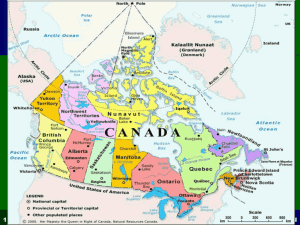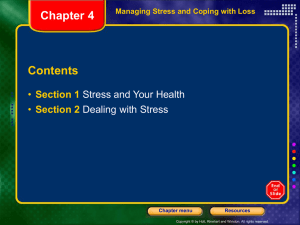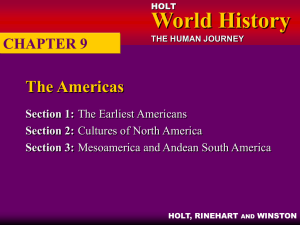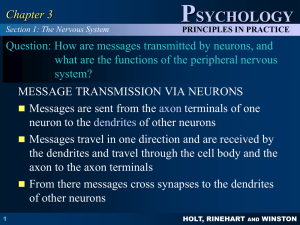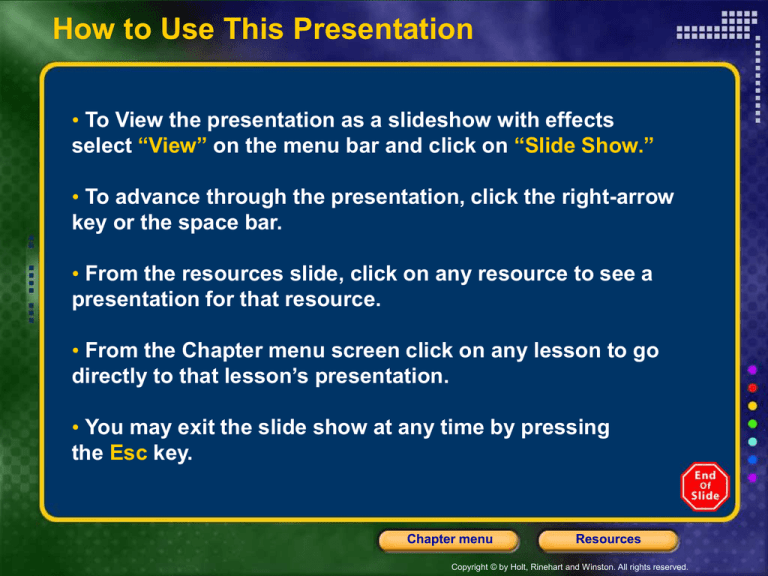
How to Use This Presentation
• To View the presentation as a slideshow with effects
select “View” on the menu bar and click on “Slide Show.”
• To advance through the presentation, click the right-arrow
key or the space bar.
• From the resources slide, click on any resource to see a
presentation for that resource.
• From the Chapter menu screen click on any lesson to go
directly to that lesson’s presentation.
• You may exit the slide show at any time by pressing
the Esc key.
Chapter menu
Resources
Copyright © by Holt, Rinehart and Winston. All rights reserved.
Resources
Chapter Presentation
Transparencies
Visual Concepts
Standardized Test Prep
Chapter menu
Resources
Copyright © by Holt, Rinehart and Winston. All rights reserved.
Chapter 29
Mollusks and Annelids
Table of Contents
Section 1 Mollusks
Section 2 Annelids
Chapter menu
Resources
Copyright © by Holt, Rinehart and Winston. All rights reserved.
Chapter 29
Section 1 Mollusks
Objectives
• Summarize the evolutionary relationship between
mollusks and annelids.
• Describe the key characteristics of mollusks.
• Describe excretion, circulation, respiration, and
reproduction in mollusks.
• Compare the body plans and feeding adaptations of
gastropods, bivalves, and cephalopods.
Chapter menu
Resources
Copyright © by Holt, Rinehart and Winston. All rights reserved.
Chapter 29
Section 1 Mollusks
A True Coelom
• Snails, slugs, oysters, clams, scallops, octopuses,
and squids are all mollusks.
• Mollusks and annelids were probably the first major
groups of organisms to develop a true coelom.
• Another feature shared by mollusks and annelids is a
larval stage called a trochophore which develops
from the fertilized egg.
Chapter menu
Resources
Copyright © by Holt, Rinehart and Winston. All rights reserved.
Chapter 29
Section 1 Mollusks
A True Coelom, continued
• In some species, the
trochophore is freeswimming and propels
itself through the water
by movement of cilia on
its surface.
• The presence of a
trochophore larva in
mollusks and annelids
suggests that they share
a common ancestor.
Chapter menu
Resources
Copyright © by Holt, Rinehart and Winston. All rights reserved.
Chapter 29
Section 1 Mollusks
Anatomy of a Trochophore
Click below to watch the Visual Concept.
Visual Concept
Chapter menu
Resources
Copyright © by Holt, Rinehart and Winston. All rights reserved.
Chapter 29
Section 1 Mollusks
Key Characteristics of Mollusks
1. The body cavity in mollusks is a true coelom,
although in most species it is reduced to a small
area immediately surrounding the heart.
2. Most mollusks exhibit bilateral symmetry.
3. Mollusks have organ systems for excretion,
circulation, respiration, digestion, and reproduction.
Chapter menu
Resources
Copyright © by Holt, Rinehart and Winston. All rights reserved.
Chapter 29
Section 1 Mollusks
Key Characteristics of Mollusks, continued
4. The body of every mollusk has three distinct parts:
the visceral mass, the mantle, and the muscular foot.
Chapter menu
Resources
Copyright © by Holt, Rinehart and Winston. All rights reserved.
Chapter 29
Section 1 Mollusks
Key Characteristics of Mollusks, continued
•
The visceral mass is a central section that
contains the mollusk’s organs.
•
The mantle is a heavy fold of tissue that forms
the outer layer of the body.
•
Finally, every mollusk has a muscular region
called a foot, which is used primarily for
locomotion.
Chapter menu
Resources
Copyright © by Holt, Rinehart and Winston. All rights reserved.
Chapter 29
Section 1 Mollusks
Key Characteristics of Mollusks, continued
5. Many mollusks have either one or two shells that
serve as an exoskeleton, protecting their soft body.
6. All mollusks except bivalves have a radula, a
tongue-like organ located in their mouth. The radula
has thousands of pointed, backward-curving teeth
arranged in rows.
Chapter menu
Resources
Copyright © by Holt, Rinehart and Winston. All rights reserved.
Chapter 29
Section 1 Mollusks
Characteristics of Mollusks
Click below to watch the Visual Concept.
Visual Concept
Chapter menu
Resources
Copyright © by Holt, Rinehart and Winston. All rights reserved.
Chapter 29
Section 1 Mollusks
Anatomy of Mollusks
Click below to watch the Visual Concept.
Visual Concept
Chapter menu
Resources
Copyright © by Holt, Rinehart and Winston. All rights reserved.
Chapter 29
Section 1 Mollusks
Radula
Click below to watch the Visual Concept.
Visual Concept
Chapter menu
Resources
Copyright © by Holt, Rinehart and Winston. All rights reserved.
Chapter 29
Section 1 Mollusks
Mollusk Body Plan
Chapter menu
Resources
Copyright © by Holt, Rinehart and Winston. All rights reserved.
Chapter 29
Section 1 Mollusks
Key Characteristics of Mollusks, continued
Organ Systems: Excretion
•
A mollusk’s coelom is a collecting place for wasteladen body fluids.
•
The beating of cilia pulls the fluid from the coelom
into tiny tubular structures called nephridia.
•
The nephridia recover useful molecules (sugars,
salts, and water) from the coelomic fluid.
Chapter menu
Resources
Copyright © by Holt, Rinehart and Winston. All rights reserved.
Chapter 29
Section 1 Mollusks
Key Characteristics of Mollusks, continued
Organ Systems: Circulation
•
In a circulatory system, blood carries nutrients and
oxygen to tissues and removes waste and carbon
dioxide.
•
Most mollusks have a three-chambered heart and
an open circulatory system.
•
Octopuses and squids are exceptions because
they each have a closed circulatory system.
Chapter menu
Resources
Copyright © by Holt, Rinehart and Winston. All rights reserved.
Chapter 29
Section 1 Mollusks
Key Characteristics of Mollusks, continued
Organ Systems: Respiration
•
Most mollusks respire with gills, which are located in
the mantle cavity.
•
Most terrestrial snails have no gills. Instead, the thin
membrane that lines their empty mantle cavity
functions like a primitive lung.
•
Sea snails also lack gills, and gas exchange takes
place directly through their skin.
Chapter menu
Resources
Copyright © by Holt, Rinehart and Winston. All rights reserved.
Chapter 29
Section 1 Mollusks
Key Characteristics of Mollusks, continued
Organ Systems: Reproduction
•
Most species of mollusks have distinct male and
female individuals, although some snails and slugs
are hermaphrodites.
•
Certain species of oysters and sea slugs are able to
change from one sex to the other and back again.
•
Many marine mollusks are moved from place to
place as their trochophore larvae drift in the ocean
currents.
Chapter menu
Resources
Copyright © by Holt, Rinehart and Winston. All rights reserved.
Chapter 29
Section 1 Mollusks
Types of Mollusks
Click below to watch the Visual Concept.
Visual Concept
Chapter menu
Resources
Copyright © by Holt, Rinehart and Winston. All rights reserved.
Chapter 29
Section 1 Mollusks
Body Plans of Mollusks
Gastropods
•
Gastropods—snails and slugs—are primarily a
marine group that has successfully invaded
freshwater and terrestrial habitats.
•
Most gastropods have a pair of tentacles on their
head with eyes often located at the tips.
•
Gastropods display varied feeding habits. Many are
herbivores that scrape algae off rocks using their
radula.
Chapter menu
Resources
Copyright © by Holt, Rinehart and Winston. All rights reserved.
Chapter 29
Section 1 Mollusks
Characteristics of Gastropods
Chapter menu
Resources
Copyright © by Holt, Rinehart and Winston. All rights reserved.
Chapter 29
Section 1 Mollusks
Body Plans of Mollusks, continued
Bivalves
•
All bivalves have a two-part hinged shell. The
valves, or shells, of a bivalve are secreted by the
mantle.
•
Two thick muscles, the adductor muscles,
connect the valves. When these muscles are
contracted, they cause the valves to close tightly.
•
Bivalves are unique among the mollusks because
they do not have a distinct head region or a
radula.
Chapter menu
Resources
Copyright © by Holt, Rinehart and Winston. All rights reserved.
Chapter 29
Section 1 Mollusks
Body Plans of Mollusks, continued
Bivalves
• Many bivalves use their
muscular foot to dig
down into the sand.
• Once there, the cilia on
their gills draw in sea
water through hollow
tubes called siphons.
Chapter menu
Resources
Copyright © by Holt, Rinehart and Winston. All rights reserved.
Chapter 29
Section 1 Mollusks
Characteristics of Bivalves
Click below to watch the Visual Concept.
Visual Concept
Chapter menu
Resources
Copyright © by Holt, Rinehart and Winston. All rights reserved.
Chapter 29
Section 1 Mollusks
Anatomy of a Clam
Click below to watch the Visual Concept.
Visual Concept
Chapter menu
Resources
Copyright © by Holt, Rinehart and Winston. All rights reserved.
Chapter 29
Section 1 Mollusks
Body Plans of Mollusks, continued
Cephalopods
•
Squids, octopuses, cuttlefish, and nautiluses are all
cephalopods. Most of their body is made up of a
large head attached to tentacles.
•
Cephalopods are the most intelligent of all
invertebrates. They have a complex nervous system
that includes a well-developed brain.
•
The structure of a cephalopod eye is similar in many
ways to that of a vertebrate eye, and some species
have color vision.
Chapter menu
Resources
Copyright © by Holt, Rinehart and Winston. All rights reserved.
Chapter 29
Section 1 Mollusks
Characteristics of Cephalopods
Click below to watch the Visual Concept.
Visual Concept
Chapter menu
Resources
Copyright © by Holt, Rinehart and Winston. All rights reserved.
Chapter 29
Section 2 Annelids
Objectives
• Identify the major change in body plan that
distinguishes annelids from mollusks.
• Describe the basic annelid body plan.
• Describe the annelid digestive system.
• Compare the three classes of annelids
Chapter menu
Resources
Copyright © by Holt, Rinehart and Winston. All rights reserved.
Chapter 29
Section 2 Annelids
The First Segmented Animals
• Annelids are easily recognized by their segments,
which are visible as a series of ringlike structures
along the length of their body.
• Some of the segments are modified for specific
functions, such as reproduction, feeding, or
sensation. A well-developed cerebral ganglion, or
primitive brain, is located in one anterior segment.
• Internal body walls, called septa, separate the
segments of most annelids.
Chapter menu
Resources
Copyright © by Holt, Rinehart and Winston. All rights reserved.
Chapter 29
Section 2 Annelids
Segmentation
Click below to watch the Visual Concept.
Visual Concept
Chapter menu
Resources
Copyright © by Holt, Rinehart and Winston. All rights reserved.
Chapter 29
Section 2 Annelids
The First Segmented Animals, continued
Characteristics of Annelids
1. The fluid-filled coelom is large and is located entirely
within the mesoderm.
2. The organ systems of annelids show a high degree
of specialization and include a closed circulatory
system and excretory structures called nephridia.
3. Most annelids have external bristles called setae.
Some annelids also have fleshy appendages called
parapodia.
Chapter menu
Resources
Copyright © by Holt, Rinehart and Winston. All rights reserved.
Chapter 29
Section 2 Annelids
Characteristics of Annelids
Click below to watch the Visual Concept.
Visual Concept
Chapter menu
Resources
Copyright © by Holt, Rinehart and Winston. All rights reserved.
Chapter 29
Section 2 Annelids
Types of Annelids
Click below to watch the Visual Concept.
Visual Concept
Chapter menu
Resources
Copyright © by Holt, Rinehart and Winston. All rights reserved.
Chapter 29
Section 2 Annelids
Annelid Groups
Marine Worms
• Marine segmented worms are members of class
Polychaeta, the largest group of annelids.
Polychaetes live in virtually all ocean habitats.
• A distinctive characteristic of polychaetes is the
pair of fleshy, paddle-like parapodia that occur on
most of their segments.
• The parapodia, which usually have setae, are
used to swim, burrow, or crawl.
Chapter menu
Resources
Copyright © by Holt, Rinehart and Winston. All rights reserved.
Chapter 29
Section 2 Annelids
Annelid Groups, continued
Marine Worms
• Nereis, a polychaete worm, grasps its prey in its
jaws, which open when it thrusts out its pharynx.
Chapter menu
Resources
Copyright © by Holt, Rinehart and Winston. All rights reserved.
Chapter 29
Section 2 Annelids
Annelid Groups, continued
Earthworms
• Earthworms and some related freshwater worms are
members of the class Oligochaeta. Oligochaetes have
no parapodia and only a few setae on each segment.
• Earthworms lack the distinctive head region of
polychaetes and have no eyes.
• Earthworms are highly specialized scavengers. They
literally eat their way through the soil, consuming their
own weight in soil every day.
Chapter menu
Resources
Copyright © by Holt, Rinehart and Winston. All rights reserved.
Chapter 29
Section 2 Annelids
Anatomy of the Earthworm
Chapter menu
Resources
Copyright © by Holt, Rinehart and Winston. All rights reserved.
Chapter 29
Section 2 Annelids
Anatomy of an Earthworm
Click below to watch the Visual Concept.
Visual Concept
Chapter menu
Resources
Copyright © by Holt, Rinehart and Winston. All rights reserved.
Chapter 29
Section 2 Annelids
Feeding Habits of an Earthworm
Click below to watch the Visual Concept.
Visual Concept
Chapter menu
Resources
Copyright © by Holt, Rinehart and Winston. All rights reserved.
Chapter 29
Section 2 Annelids
Annelid Groups, continued
Hydrostatic Skeleton
• The fluid within the coelom of each body segment
creates a hydrostatic skeleton that supports the
segment.
• Each segment contains muscles that pull against this
hydrostatic skeleton.
• Circular muscles wrap around the segment, while
longitudinal muscles span its length.
Chapter menu
Resources
Copyright © by Holt, Rinehart and Winston. All rights reserved.
Chapter 29
Section 2 Annelids
Movement of an Earthworm
Click below to watch the Visual Concept.
Visual Concept
Chapter menu
Resources
Copyright © by Holt, Rinehart and Winston. All rights reserved.
Chapter 29
Section 2 Annelids
Annelid Groups, continued
Leeches
• A leech has suckers at both ends of its body. Most
species are predators or scavengers, but some are
parasites of vertebrates and crustaceans.
• Leeches are the only members of class Hirudinea.
Leeches lack both setae and parapodia.
• The body of a leech is flattened, and unlike other
annelids, its segments are not separated internally.
Chapter menu
Resources
Copyright © by Holt, Rinehart and Winston. All rights reserved.
Chapter 29
Standardized Test Prep
Multiple Choice
Use the diagram below to answer questions 1–3.
Chapter menu
Resources
Copyright © by Holt, Rinehart and Winston. All rights reserved.
Chapter 29
Standardized Test Prep
Multiple Choice, continued
1. Which structure is part of the respiratory system?
A.
B.
C.
D.
A
B
C
D
Chapter menu
Resources
Copyright © by Holt, Rinehart and Winston. All rights reserved.
Chapter 29
Standardized Test Prep
Multiple Choice, continued
1. Which structure is part of the respiratory system?
A.
B.
C.
D.
A
B
C
D
Chapter menu
Resources
Copyright © by Holt, Rinehart and Winston. All rights reserved.
Chapter 29
Standardized Test Prep
Multiple Choice, continued
2. Which structure is part of the digestive system?
F.
G.
H.
J.
A
B
C
D
Chapter menu
Resources
Copyright © by Holt, Rinehart and Winston. All rights reserved.
Chapter 29
Standardized Test Prep
Multiple Choice, continued
2. Which structure is part of the digestive system?
F.
G.
H.
J.
A
B
C
D
Chapter menu
Resources
Copyright © by Holt, Rinehart and Winston. All rights reserved.
Chapter 29
Standardized Test Prep
Multiple Choice, continued
3. One characteristic shown by this mollusk is
A.
B.
C.
D.
cephalization.
radial symmetry.
body segmentation.
a pseudocoelom.
Chapter menu
Resources
Copyright © by Holt, Rinehart and Winston. All rights reserved.
Chapter 29
Standardized Test Prep
Multiple Choice, continued
3. One characteristic shown by this mollusk is
A.
B.
C.
D.
cephalization.
radial symmetry.
body segmentation.
a pseudocoelom.
Chapter menu
Resources
Copyright © by Holt, Rinehart and Winston. All rights reserved.

